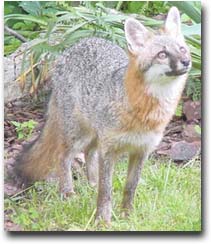 Research work that is studying factors that affect Indiana gray fox populations and distribution is moving into the data analysis phase. See updates from the researcher. Report gray fox observations.
Research work that is studying factors that affect Indiana gray fox populations and distribution is moving into the data analysis phase. See updates from the researcher. Report gray fox observations.
Gray foxes (Urocyon cinereoargenteus) are a unique canid (member of the dog family) because they are capable of climbing trees. Unlike dogs, coyotes, and red foxes, their claws partially retract, allowing them to stay sharp enough to climb a tree. Because of this skill, many people used to think they were more closely related to cats, but they are a true fox and in the dog family just like red foxes and coyotes.
General Description
- Primarily grizzled gray with reddish coloration on their legs and necks and white or cream-colored bellies and throat.
- Gray foxes usually have a distinct black stripe down the top of their tail ending in a black tip. There usually is not a white tip like on red foxes.
- Two black lines can be found on the muzzle behind the nose.
- Backs of ears are gray and reddish brown, unlike the black-backed ears of red foxes.
- Gray foxes average 8–12 pounds.
Similar Species
Distribution and Abundance
Gray foxes are native to Indiana, unlike the red fox which expanded its range into Indiana through introductions by early European settlers. As the land became cleared of timber, gray fox habitat was reduced. They prefer forests and brushy woodlands. The gray fox occurs in all Indiana counties where suitable habitat exists, but are more common in the forested south-central hills region.
Reproduction
Gray foxes mate in January and three to five pups are born during March or April. The gray fox uses a ground den less frequently than red foxes and may use a hollow tree or log, or a burrow hidden in rock outcroppings. Gray foxes stay mated for a least one season and may remain together for life. The male brings food to the female when she is nursing, and when the pups begin to eat solid food, he assists her in catching and bringing food to them. The family group breaks up in early fall when the young have learned to hunt.
Food Habits
Gray foxes eat a variety of mammals, birds, insects, and plants.
- Winter diets have been studied in Indiana and include nuts, seeds, fruit, vegetation, rabbits, mice, and birds.
- Summer diets are likely similar, but include more fruit and insects.
- Gray foxes will also scavenge for food.
Viewing Tips
Gray foxes are often elusive but can occasionally be seen venturing out from thick brushy areas into fields to look for mice, voles, and plants that they prefer to eat in the evenings. They are most likely to be seen in southern Indiana counties like Perry, Crawford, and Harrison. Harrison-Crawford State Forest and Patoka Lake are public lands where you could have an opportunity to see a gray fox, especially if you are taking a night drive or camping. Gray foxes make a hoarse, gravelly bark that can be easily confused with that of a red fox; but are less talkative than their distant cousins and less likely to be heard.
Management and Control
Gray foxes are recognized as an important predator in our wildlife community. They may be hunted and trapped during the regulated season. They are protected from hunting and trapping during the breeding season and while rearing young. Information about seasons and harvest limits may be found on the hunting and trapping page.
Gray foxes are subject to canine diseases and parasite infections such as distemper, parvovirus, heartworm, and in rare instances, rabies. Fortunately, rabies is seldom encountered among Indiana foxes. Internal parasites, such as tapeworms, roundworms, and lungworms may lower their resistance to other diseases.
Gray foxes may be removed by a landowner or tenant without a permit if the animal is causing damage or posing a threat to humans. Landowners and tenants may designate someone to assist them if the designated person has a trapping or hunting license, does not receive any compensation, and is given written permission by the landowner or tenant. Individuals may hire a Wildlife Control Operator for help with wildlife conflicts.
